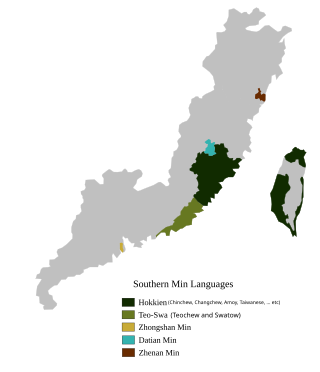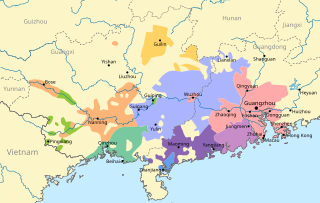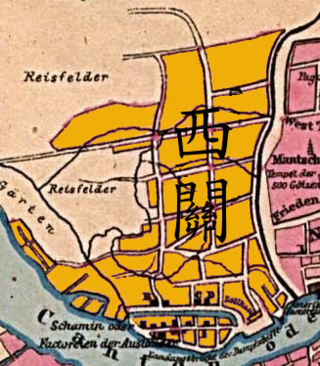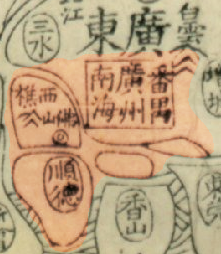
The Linguistic Society of Hong Kong Cantonese Romanization Scheme, also known as Jyutping, is a romanisation system for Cantonese developed in 1993 by the Linguistic Society of Hong Kong (LSHK).

Macanese patois, known as patuá to its speakers, is a Portuguese-based creole language with a substrate from Cantonese, Malay and Sinhala, which was originally spoken by the Macanese community of the Portuguese colony of Macau. It is now spoken by a few families in Macau and in the Macanese diaspora.

Cantonese is a language within the Chinese (Sinitic) branch of the Sino-Tibetan languages originating from the city of Guangzhou and its surrounding Pearl River Delta. It is the traditional prestige variety of the Yue Chinese group, which has over 82.4 million native speakers. While the term Cantonese specifically refers to the prestige variety, it is often used to refer to the entire Yue subgroup of Chinese, including related but partially mutually intelligible varieties like Taishanese.

Teochew or Chaozhou, also called Teo-Swa or Chaoshan Chinese: 潮汕話, Teochew: Dio5suan3 uê7, Mandarin: Cháoshàn huà) is a Southern Min language spoken by the Teochew people in the Chaoshan region of eastern Guangdong and by their diaspora around the world. It is sometimes referred to as Chiuchow, its Cantonese rendering, due to English romanization by colonial officials and explorers. It is closely related to Hokkien, as it shares some cognates and phonology with Hokkien. The two are mutually unintelligible, but it is possible to understand some words.
Starting in the 1980s, proper Cantonese pronunciation has been much promoted in Hong Kong, with the scholar Richard Ho (何文匯) as its iconic campaigner. The very idea of proper pronunciation of Cantonese is controversial, since the concept of labeling native speakers' usage and speech in terms of correctness is not generally supported by linguistics. Law et al. (2001) point out that the phrase 懶音 laan5 jam1 "lazy sounds," most commonly discussed in relation to phonetic changes in Hong Kong Cantonese, implies that the speaker is unwilling to put forth sufficient effort to articulate the standard pronunciation.
A syllabic consonant or vocalic consonant is a consonant that forms a syllable on its own, like the m, n and l in some pronunciations of the English words rhythm, button and bottle, respectively. To represent it, the understroke diacritic in the International Phonetic Alphabet is used, ⟨U+0329◌̩COMBINING VERTICAL LINE BELOW⟩. It may be instead represented by an overstroke, ⟨U+030D◌̍COMBINING VERTICAL LINE ABOVE⟩ if the symbol that it modifies has a descender, such as in.
Cantonese Pinyin is a romanization system for Cantonese developed by the Rev. Yu Ping Chiu (余秉昭) in 1971, and subsequently modified by the Education Department of Hong Kong and Zhan Bohui (詹伯慧) of the Chinese Dialects Research Centre of the Jinan University, Guangdong, PRC, and honorary professor of the School of Chinese, University of Hong Kong. It is the only romanization system accepted by Education and Manpower Bureau of Hong Kong and Hong Kong Examinations and Assessment Authority.
Wong Shik Ling published a scheme of phonetic symbols for Cantonese based on the International Phonetic Alphabet (IPA) in the book A Chinese Syllabary Pronounced According to the Dialect of Canton. The scheme has been widely used in Chinese dictionaries published in Hong Kong. The scheme, known as S. L. Wong system (黃錫凌式), is a broad phonemic transcription system based on IPA and its analysis of Cantonese phonemes is grounded in the theories of Y. R. Chao.
Hong Kong Cantonese is a dialect of the Cantonese language of the Sino-Tibetan family.
Articles related to Hong Kong include:
Cantonese naamyam is a unique local narrative singing tradition in Cantonese dialect/language, different from the nanyin tradition originating from southern Fujian. A singer would be engaged for a single performance or for regular performances over an extended period of time. Famous naamyam singers included Chung Tak (1860–1929), Dou Wun, Yuen Siu-fai and Au Kwan-cheung.
Standard Cantonese pronunciation is that of Guangzhou, also known as Canton, capital of Guangdong Province. Hong Kong Cantonese is related to Guangzhou dialect, and they diverge only slightly. Yue dialects in other parts of Guangdong and Guangxi provinces like Taishanese, may be considered divergent to a greater degree.

Twilight of a Nation is a Hong Kong television series based on the events of the Taiping Rebellion and the rise and fall of the Taiping Heavenly Kingdom during the late Qing dynasty. The 45 episodes long series was produced by Siu Sang and was first aired on TVB Jade in Hong Kong in November 1988. It was broadcast again on TVB in 1996. The theme songs and insert songs in the series were performed by Roman Tam.

The Qin–Lian language is a southern branch of Yue Chinese spoken in the coastal part of Guangxi, including 3 main cities: Beihai, Qinzhou, Fangchenggang, and four subject counties: Hepu, Pubei, Lingshan, Dongxing.

Yuehai is the main branch of Yue Chinese, spoken in the Pearl River Delta of the province of Guangdong, as well as Hong Kong and Macau. It is commonly called Cantonese, though that name is more precisely applied to the Guangzhou topolect of Yuehai.

Sai Kwan or Xiguan is an ancient town and an area in the Liwan district of Guangzhou, China, which was located west of the old walled city. The Thirteen Factories trading enclave was located on its southern shore and the Shamian enclave was constructed beside it. Xiguan continues to have a distinctive culture within Guangzhou and some residents speak a distinctive dialect of Cantonese.

Sanyi or Nanpanshun, also known by Cantonese romanizations such as Sam Yup and Nam Pun Shun, refers to the three districts of Nanhai, Panyu and Shunde surrounding Guangzhou and Foshan in Guangdong, China.
Cantonese Bopomofo, or Cantonese Phonetic Symbols is an extended set of Bopomofo characters used to transcribe Yue Chinese and, specifically, its prestige Cantonese dialect. It was first introduced in early 1930s, and then standardized in 1950. It fell into disuse along with the original Bopomofo for Mandarin Chinese in the late 1950s.
The Fangcheng dialect also rendered Fongsing Jyut dialect, is a dialect of Yue (Cantonese), spoken in the southern area closer to the sea of former Fangcheng County(防城縣), which was divided present-day Dongxing City(東興市), Fangcheng District(防城區) and Gangkou District(港口區).

Irreconcilable is the first Cantonese studio album recorded by Taiwanese singer Teresa Teng, released via Polydor Records on December 18, 1980. The album was supported with the single "Forget Him", which was written by Hong Kong media personality James Wong Jim.









